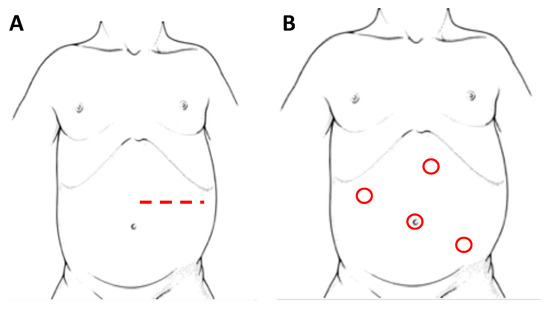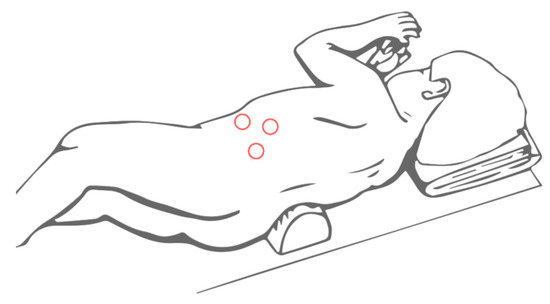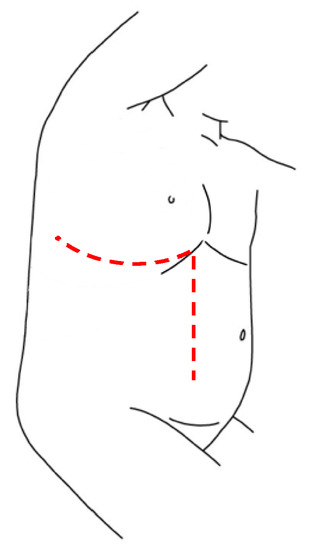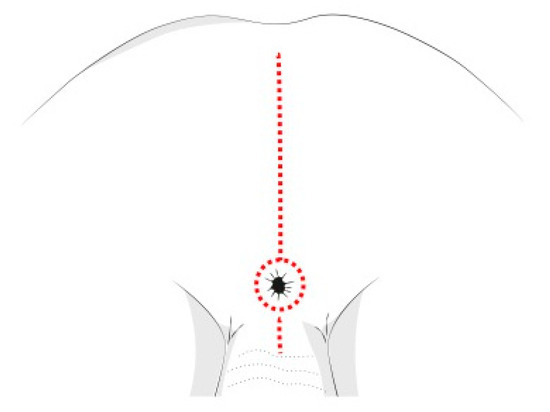Neuroblastoma (NB) is the most commonly occurring soft-tissue malignancy of childhood. Surgery plays an important role in multidisciplinary treatment and its principal aim is a local control of the disease, respecting the integrity of the surrounding structures. There is no unanimous consensus on the best surgical technique, and the operative approach largely depends on the anatomical location and the extension of the mass. To have a complete overview of the different type of treatment, we made a review of the literature from the last twenty years of all the surgical approaches applied for NBs resection, accordingly to the anatomical site.
- neuroblastoma
- surgery
- thoracotomy
- laparotomy
- innovative techniques
- laparoscopy
- thoracoscopy
1. Introduction
2. Cervico-Thoracic Tumors
2.1. Open Surgery

2.2. Thoracoscopy
| Author/Year | N Patient | Age (Months) | Surgical Approach | Operative Time (Minutes) | Conversion | Stage | Type | N-Myc ampL | Hospital Stay (Days) | Post-Operative Complication | Outcome | Follow Up Months |
|---|---|---|---|---|---|---|---|---|---|---|---|---|
| Decou, J. 2005 [29] |
5 | 27.2 | TS | 108.6 | none | 1 | NB | no | 2.6 | 2 spillage | alive, complete remission | 29.2 |
| Fraga, J.C. 2010 [21] |
43 | 36 | TT (n = 38); TS (n = 5) | TT 132; TS 180 | none | 8 stage I, 11 stage II, 8 stage III, 6 stage IV, 3 stage IVS | 10 NB, 13 GNB, 10 GN |
ND | TT 6; TS 4 | 5 Horner syndr 2 chylothorax; 2 pnuemothorax, 1 empiema, 1 tracheomalacia and paralysis of diaphragm | 4 recurrences, 2 deaths |
41.5 |
| Fraga, J.C. 2012 [28] |
17 | 16 | TS | 90 | none | 4 stage I, 5 stage II, 3 stage III, 1 stage IV-S | 10 NB, 3 GNB, 4 GN |
3 | 2 Horner syndrome | alive, complete remission | 16 | |
| Irtan, S. 2014 [25] |
20 | 39 | TS | ND | 2 | 5 L1, 5 L2, 7 M, 3 MS | 3 GN, 9 NB, 8 GNB |
ND | ND | 1 Horner syndr, 3 chylothorax | alive, complete remission | 33 |
| Lacreuse, I. 2007 [26] |
21 | 72 | TS | 100 | none | ND | 9 NB, 9GNB, 3 GN |
no | 4.5 | 2 chylothorax | alive, complete remission | 48 |
| Malek, M.M. 2010 [27] |
37 | 13 (TS), 6 (TT) |
TS (n = 11), TT (n = 26) | TS 150, TT 180 | none | 10 stage I, 18 stage II 18, 3 stage III, 4 stage IV | NB | 2 | TS 2, TT 3.5 | 2 Horner’s syndrome, 1 chylothorax, 1 postoperative scoliosis, and 1 severe atelectasis | 5 recurrence, 23 free survival | ND |
| Nio, M. 2005 [23] |
6 | 42 | TS | 230 | none | ND | 1 NB, 2 GNB, 3 GN, |
ND | 7.6 | none | ND | 49 |
| Petty, J.K. 2006 [20] |
17 | 10 (TS), 7 (TT) |
TS (n = 10), TT (n = 7) | TS 54, TT 138 | 1 | 5 stage I, 3 stage II, 2 stage IV | 10 NB, 5 GN, 1 MPST |
ND | TS 2, TT 4 | 5 Horner syndr, 1 pleural effusion | 1 tumour progression | 19 |
3. Adrenal Tumors
3.1. Open Surgery

3.2. Minimally Invasive Surgery


| Author/Year | N Patient | Age (Months) | Surgical Approach | Operative Time (Minutes) | Conversion | Hospital Stay (Days) | Post-Operative Complication | Outcome | Follow Up Months |
|---|---|---|---|---|---|---|---|---|---|
| Catellani et al., 2014 [38] | 4 | 87 | TLLA | 85–125 | 0 | 3.75 | 0 | Alive, no disease recurrence | 35.25 |
| Mirallié et al., 2001 [40] | 6 | 97.34 | LA | 191.25 | 2 | / | 0 | 1 patient remained hypertensive | 1 |
| Mitra et al., 2020 [41] | 3 | 76 | Robotic-assisted LA | 244 | 0 | 2 | 1 morbilliform eruption | Alive, no disease recurrence | 19 |
| Al-Shanafey 2008 [42] | 29 | 36 | TLA | 144 | 3 | 2 | 0 | Alive, no disease recurrence | 36 |
| De Barros et al., 2012 [30] | 7 | 27 | TLA | 138.6 | 1 | 2.9 | 0 | Alive, no disease recurrence | 18.8 |
| De Lagausie et al., 2003 [43] | 9 | 38 | LA | / | 1 | 4.5 | 1 | 1 disease recurrence | / |
| Fascetti Leon et al., 2016 [32] | 68 | 62 | 63 TLA 5 RPSA |
227.5 | / | 4.5 | / | 2 disease recurrence | 52 |
| Kadamba et al., 2004 [44] | 10 | 48 | TLA | 235.5 | 2 | 3 | 0 | 1 death for tumor dissemination, 1 patient on chemotherapic treatment |
24 |
| Kelleher et al., 2013 [45] | 79 | 32.3 | 61 OA 18 LA |
OA 292 LA 168.5 |
2 | OA 10.4 LA 3.5 |
1 sepsis (LPT group) | 23 deaths | OA 56.5 LA 30.5 |
| Kouch et al., 2003 [46] | 6 | 8.5 | RPSA | 195 | 0 | / | / | Alive, no disease recurrence | 15-29 |
| Lopes et al., 2012 [47] | 19 | 46.8 | LA | 138.5 | 0 | 3.5 | 0 | 4 disease recurrence | 81 |
| Mattioli et al., 2014 [48] | 55 | 14 | LA | 90 | 0 | 4 | 0 | Alive, no disease recurrence | 27 |
| Nerli et al., 2011 [49] | 18 | 69.6 | LA | 95 | 0 | 2 | 0 | Alive, no disease recurrence | 39 |
| Peter et al., 2011 [50] | 140 | 105.6 | LA | 140.7 | 13 | / | 1 renal infarction | 1 local recurrence | 18 |
| Saad et al., 2005 [51] | 6 | 26.2 | LA | 149.2 | 0 | 1 | 0 | / | 21 |
| Yao et al., 2018 [52] | 37 | 37.24 | 24 OA 13 LA |
OA 143.13 LA 143.85 |
2 | 2 | / | 2 disease recurrence * | 86.78 |
| Meignan et al., 2017 [53] | 3 | 11.7 | Robot-assisted LA | 104.3 | 0 | 2.3 | 0 | Alive, no disease recurrence | 41.6 |
| Stanford et al., 2002 [54] | 64 | OA 106.8 LA 168 |
60 OA 4 LA |
OA 236 LA 264 |
/ | OA 5.4 LA 2.7 |
0 | 2 local recurrence | / |
| Romano et al., 2007 [37] | 26 | OA 41.7 RPSA 62.4 |
19 OA 7 RPSA |
OA 203.7 RPSA 97.1 |
0 | / | 0 | 3 deaths * 3 patients on chemotherapic treatment |
/ |
3.3. Adrenal-Sparing Surgery
4. Abdominal Tumors
5. Pelvic Tumors
6. New Surgical Approaches


This entry is adapted from the peer-reviewed paper 10.3390/children8060446
References
- Ryan, A.L.; Akinkuotu, A.; Pierro, A.; Morgenstern, D.A.; Irwin, M.S. The role of surgery in high-risk neuroblastoma. J. Pediatr. Hematol. Oncol. 2020, 42, 1–7.
- Zhang, A.-A.; Pan, C.; Xu, M.; Wang, X.-X.; Ye, Q.-D.; Gao, Y.-J.; Tang, J.-Y. Association of image-defined risk factors, tumor resectability, and prognosis in children with localized neuroblastoma. World J. Pediatr. 2019, 15, 572–579.
- Rojas, Y.; Jaramillo, S.; Lyons, K.; Mahmood, N.; Wu, M.-F.; Liu, H.; Vasudevan, S.A.; Guillerman, R.P.; Louis, C.U.; Russell, H.V.; et al. The optimal timing of surgical resection in high-risk neuroblastoma. J. Pediatr. Surg. 2016, 51, 1665–1669.
- Park, J.R.; Bagatell, R.; London, W.B.; Maris, J.M.; Cohn, S.L.; Mattay, K.K.; Hogarty, M. Children’s Oncology Group’s 2013 blueprint for research: Neuroblastoma. Pediatr. Blood Cancer. 2013, 60, 985–993.
- Parikh, D.; Short, M.; Eshmawy, M.; Brown, R. Surgical outcome analysis of paediatric thoracic and cervical neuroblastoma. Eur. J. Cardio-Thoracic Surg. 2011, 41, 630–634.
- Sauvat, F.; Brisse, H.; Magdeleinat, P.; Lopez, M.; Philippe-Chomette, P.; Orbach, D.; Aerts, I.; Brugieres, L.; Revillon, Y.; Sarnacki, S. The transmanubrial approach: A new operative approach to cervicothoracic neuroblastoma in children. Surgery 2006, 139, 109–114.
- Grunenwald, D.; Spaggiari, L. Transmanubrial Osteomuscular Sparing Approach for Apical Chest Tumors. Ann. Thorac. Surg. 1997, 63, 563–566.
- Ahmed, G.; Hegazy, M.M.; Raafat, T.; Hafez, H.; Fadel, S.; Elshafiey, M. Surgical approaches, anaesthetic management and outcome in pediatric superior mediastinal tumors. J. Egypt. Natl. Cancer Inst. 2017, 29, 147–153.
- Pimpalwar, A.P.; Kroeker, T.R.; Ramachandran, V. Cervicothoracic neuroblastoma arising from the stellate ganglion in children: The use of muscle and bone sparing transmanubrial transcostal approach. J. Pediatr. Surg. 2008, 43, e31–e34.
- El Madi, A.; Irtan, S.; Sauvat, F.; Zérah, M.; Schleiermacher, G.; Galmiche-Roland, L.; Minard-Colin, V.; Brisse, H.; Sarnacki, S. Long-term results of the transmanubrial osteomuscular-sparing approach for pediatric tumors. Pediatr. Blood Cancer 2017, 64, e26527.
- Pranikoff, T.; Hirschl, R.B.; Schnaufer, L. Approach to cervicothoracic neuroblastomas via a trap-door incision. J. Pediatr. Surg. 1995, 30, 546–548.
- Chui, C.H.; Thirugnanam, A. Trapdoor anterior thoracotomy for cervicothoracic and apical thoracic neuroblastoma in children. Pediatr. Surg. Int. 2020, 36, 891–895.
- Qureshi, S.S.; Kembhavi, S.; Ramadwar, M.; Chinnaswamy, G.; Laskar, S.; Talole, S.; Desai, S.; Khanna, N.; Vora, T.; Kurkure, P. Outcome and morbidity of surgical resection of primary cervical and cervicothoracic neuroblastoma in children: A comparative analysis. Pediatr. Surg. Int. 2014, 30, 267–273.
- Ladas, G.; Rhys-Evans, P.H.; Goldstraw, P. Anterior cervical–transsternal approach for resection of benign tumors at the thoracic inlet. Ann. Thorac. Surg. 1999, 67, 785–789.
- De Corti, F.; Avanzini, S.; Cecchetto, G.; Buffa, P.; Guida, E.; Zanon, G.F.; Jasonni, V. The surgical approach for cervicothoracic masses in children. J. Pediatr. Surg. 2012, 47, 1662–1668.
- McMahon, S.V.; Menon, S.; McDowell, D.T.; Yeap, B.; Russell, J.; Corbally, M.T. The use of the trapdoor incision for access to thoracic inlet pathology in children. J. Pediatr. Surg. 2013, 48, 1147–1151.
- Jones, V.S.; Pitkin, J. Navigating the thoracic inlet in children. Pediatr. Surg. Int. 2007, 24, 491–494.
- Martucciello, G.; Fati, F.; Avanzini, S.; Senes, F.; Paraboschi, I. The Cervico-Parasternal Thoracotomy (CPT): A New Surgical Approach for the Resection of Cervicothoracic Neuroblastomas. Children 2021, 8, 229.
- Dingemann, C.; Ure, B.; Dingemann, J. Thoracoscopic procedures in pediatric surgery: What is the evidence? Eur. J. Pediatr. Surg. Off. J. Austrian Assoc. 2014, 24, 14–19.
- Petty, J.K.; Bensard, D.D.; Partrick, D.A.; Hendrickson, R.J.; Albano, E.A.; Karrer, F.M. Resection of Neurogenic Tumors in Children: Is Thoracoscopy Superior to Thoracotomy? J. Am. Coll. Surg. 2006, 203, 699–703.
- Fraga, J.C.; Aydogdu, B.; Aufieri, R.; Silva, G.V.; Schopf, L.; Takamatu, E.; Brunetto, A.; Kiely, E.; Pierro, A. Surgical Treatment for Pediatric Mediastinal Neurogenic Tumors. Ann. Thorac. Surg. 2010, 90, 413–418.
- Fuchs, J. The role of minimally invasive surgery in pediatric solid tumors. Pediatr. Surg. Int. 2015, 31, 213–228.
- Nio, M.; Nakamura, M.; Yoshida, S.; Ishii, T.; Amae, S.; Hayashi, Y. Thoracoscopic Removal of Neurogenic Mediastinal Tumors in Children. J. Laparoendosc. Adv. Surg. Tech. 2005, 15, 80–83.
- Partrick, D.A.; Rothenberg, S.S. Thoracoscopic resection of mediastinal masses in infants and children: An evaluation of technique and results. J. Pediatr. Surg. 2001, 36, 1165–1167.
- Irtan, S.; Brisse, H.J.; Minard-Colin, V.; Schleiermacher, G.; Canale, S.; Sarnacki, S. Minimally invasive surgery of neuroblastic tumors in children: Indications depend on anatomical location and image-defined risk factors. Pediatr. Blood Cancer 2014, 62, 257–261.
- Lacreuse, I.; Valla, J.S.; De Lagausie, P.; Varlet, F.; Héloury, Y.; Temporal, G.; Bastier, R.; Becmeur, F. Thoracoscopic resection of neurogenic tumors in children. J. Pediatr. Surg. 2007, 42, 1725–1728.
- Malek, M.M.; Mollen, K.P.; Kane, T.D.; Shah, S.R.; Irwin, C. Thoracic neuroblastoma: A retrospective review of our institutional experience with comparison of the thoracoscopic and open approaches to resection. J. Pediatr. Surg. 2010, 45, 1622–1626.
- Fraga, J.C.; Rothenberg, S.; Kiely, E.; Pierro, A. Video-assisted thoracic surgery resection for pediatric mediastinal neurogenic tumors. J. Pediatr. Surg. 2012, 47, 1349–1353.
- Decou, J.M.; Schlatter, M.G.; Mitchell, D.S.; Abrams, R.S. Primary Thoracoscopic Gross Total Resection of Neuroblastoma. J. Laparoendosc. Adv. Surg. Tech. 2005, 15, 470–473.
- de Barros, F.; Romão, R.L.P.; de Pinho-Apezzato, M.L.; Velhote, M.C.P.; Ricardi, L.R.S.; Leal, A.J.G.; Tannuri, A.C.A.; Carvalho, B.; Odone-Filho, V.; Tannuri, U. Laparoscopic Adrenalectomy in Children for Neuroblastoma. Surg. Laparosc. Endosc. Percutaneous Tech. 2012, 22, 79–81.
- Gagner, M.; Lacroix, A.; Bolté, E. Laparoscopic Adrenalectomy in Cushing’s Syndrome and Pheochromocytoma. New Engl. J. Med. 1992, 327, 1033.
- Fascetti-Leon, F.; Scotton, G.; Pio, L.; Beltrà, R.; Caione, P.; Esposito, C.; Mattioli, G.; Saxena, A.K.; Sarnacki, S.; Gamba, P. Minimally invasive resection of adrenal masses in infants and children: Results of a European multi-center survey. Surg. Endosc. 2017, 31, 4505–4512.
- Galazka, P.; Czyzewski, K.; Marjanska, A.; Daniluk-Matras, I.; Styczynski, J. minimally invasive surgery in pediatric oncology: Proposal of guidelines. Anticancer Res. 2019, 39, 5853–5859.
- Laje, P.; Mattei, P.A. Laparoscopic Adrenalectomy for Adrenal Tumors in Children: A Case Series. J. Laparoendosc. Adv. Surg. Tech. 2009, 19, s27–s29.
- Boutros, J.; Bond, M.; Beaudry, P.; Blair, G.K.; Skarsgard, E.D. Case selection in minimally invasive surgical treatment of neuroblastoma. Pediatr. Surg. Int. 2008, 24, 1177–1180.
- Monclair, T.; Brodeur, G.M.; Ambros, P.F.; Brisse, H.J.; Cecchetto, G.; Holmes, K.; Kaneko, M.; London, W.B.; Matthay, K.K.; Nuchtern, J.G.; et al. The international neuroblastoma risk group (INRG) staging system: An INRG task force report. J. Clin. Oncol. 2009, 27, 298–303.
- Romano, P.; Avolio, L.; Martucciello, G.; Steyaert, H.; Valla, J.S. Adrenal Masses in Children. Surg. Laparosc. Endosc. Percutaneous Tech. 2007, 17, 504–507.
- Catellani, B.; Acciuffi, S.; Biondini, D.; Ceccarelli, P.L.; Cacciari, A.; Gelmini, R. Transperitoneal Laparoscopic Adrenalectomy in Children. JSLS J. Soc. Laparoendosc. Surg. 2014, 18, 18.
- Lee, Y.T.; Samsudin, H.; Ong, C.C.; Tang, P.H.; Lim, K.B.; Loh, A.H. Posterior retroperitoneoscopic adrenalectomy for pediatric adrenal tumors. J. Pediatr. Surg. 2019, 54, 2348–2352.
- Mirallié, E.; Leclair, M.-D.; De Lagausie, P.; Weil, D.; Plattner, V.; Duverne, C.; De Wint, A.; Podevin, G.; Héloury, Y. Laparoscopic adrenalectomy in children. Surg. Endosc. 2001, 15, 156–160.
- Mitra, A.P.; Vasquez, E.; Kokorowski, P.; Chang, A.Y. Robotic adrenalectomy in the pediatric population: Initial experience case series from a tertiary center. BMC Urol. 2020, 20, 1–5.
- Al-Shanafey, S.; Habib, Z. Feasibility and Safety of Laparoscopic Adrenalectomy in Children: Special Emphasis on Neoplastic Lesions. J. Laparoendosc. Adv. Surg. Tech. 2008, 18, 306–309.
- De Lagausie, P.; Berrebi, D.; Michon, J.; Philippe-Chomette, P.; El Ghoneimi, A.; Garel, C.; Brisse, H.; Peuchmaur, M.; Aigrain, Y. Laparoscopic Adrenal Surgery for Neuroblastomas in Children. J. Urol. 2003, 170, 932–935.
- Kadamba, P.; Habib, Z.; Rossi, L. Experience with laparoscopic adrenalectomy in children. J. Pediatr. Surg. 2004, 39, 764–767.
- Kelleher, C.M.; Smithson, L.; Nguyen, L.L.; Casadiego, G.; Nasr, A.; Irwin, M.S.; Gerstle, J.T. Clinical outcomes in children with adrenal neuroblastoma undergoing open versus laparoscopic adrenalectomy. J. Pediatr. Surg. 2013, 48, 1727–1732.
- Kouch, K.; Yoshida, H.; Matsunaga, T.; Ohtsuka, Y.; Okada, T.; Saito, T.; Matsuura, G.; Yamada, H.; Ohnuma, N. Extirpation of mass-screened adrenal neuroblastomas by retroperitoneoscopy. Surg. Endosc. 2003, 17, 1769–1772.
- Lopes, R.I.; Dénes, F.T.; Bissoli, J.; Mendonca, B.; Srougi, M. Laparoscopic adrenalectomy in children. J. Pediatr. Urol. 2012, 8, 379–385.
- Mattioli, G.; Avanzini, S.; Prato, A.P.; Pio, L.; Granata, C.; Garaventa, A.; Conte, M.; Manzitti, C.; Montobbio, G.; Buffa, P. Laparoscopic resection of adrenal neuroblastoma without image-defined risk factors: A prospective study on 21 consecutive pediatric patients. Pediatr. Surg. Int. 2014, 30, 387–394.
- Nerli, R.B.; Reddy, M.N.; Guntaka, A.; Patil, S.; Hiremath, M. Laparoscopic adrenalectomy for adrenal masses in children. J. Pediatr. Urol. 2011, 7, 182–186.
- Peter, S.D.S.; Valusek, P.A.; Hill, S.; Wulkan, M.L.; Shah, S.S.; Ferro, M.M.; Laje, P.; Mattei, P.A.; Graziano, K.D.; Muensterer, O.J.; et al. Laparoscopic Adrenalectomy in Children: A Multicenter Experience. J. Laparoendosc. Adv. Surg. Tech. 2011, 21, 647–649.
- Saad, D.F.; Gow, K.W.; Milas, Z.; Wulkan, M.L. Laparoscopic adrenalectomy for neuroblastoma in children: A report of 6 cases. J. Pediatr. Surg. 2005, 40, 1948–1950.
- Yao, W.; Dong, K.; Li, K.; Zheng, S.; Xiao, X. Comparison of long-term prognosis of laparoscopic and open adrenalectomy for local adrenal neuroblastoma in children. Pediatr. Surg. Int. 2018, 34, 851–856.
- Meignan, P.; Ballouhey, Q.; Lejeune, J.; Braik, K.; Longis, B.; Cook, A.R.; Lardy, H.; Fourcade, L.; Binet, A. Robotic-assisted laparoscopic surgery for pediatric tumors: A bicenter experience. J. Robot. Surg. 2018, 12, 501–508.
- Stanford, A.; Upperman, J.S.; Nguyen, N.; Barksdale, E.; Wiener, E.S. Surgical management of open versus laparoscopic adrenalectomy: Outcome analysis. J. Pediatr. Surg. 2002, 37, 1027–1029.
- Reismann, M.; Wehrmann, F.; Schukfeh, N.; Kuebler, J.F.; Ure, B.; Glüer, S. Carbon dioxide, Hypoxia and Low pH Lead to Overexpression of c-myc and HMGB-1 Oncogenes in Neuroblastoma Cells. Eur. J. Pediatr. Surg. 2009, 19, 224–227.
- Montalto, A.S.; Currò, M.; Russo, T.; Ferlazzo, N.; Caccamo, D.; Ientile, R.; Romeo, C.; Impellizzeri, P. CO2 Pneumoperitoneum Effects on Molecular Markers of Tumor Invasiveness in SH-SY5Y Neuroblastoma Cells. Eur. J. Pediatr. Surg. 2020, 30, 524–528.
- Chui, C.H.; Chang, K.T.E. The feasibility of adrenal-sparing surgery in bilateral adrenal neuroblastoma. J. Pediatr. Surg. 2020, 55, 2836–2839.
- Iwanaka, T.; Kawashima, H.; Uchida, H. The laparoscopic approach of neuroblastoma. Semin. Pediatr. Surg. 2007, 16, 259–265.
- Holmes, K.; Pötschger, U.; Pearson, A.D.J.; Sarnacki, S.; Cecchetto, G.; Gomez-Chacon, J.; Squire, R.; Freud, E.; Bysiek, A.; Matthyssens, L.E.; et al. Influence of surgical excision on the survival of patients with stage 4 high-risk neuroblastoma: A report from the HR-NBL1/SIOPEN study. J. Clin. Oncol. Off. J. Am. Soc. Clin. Oncol. 2020, 38, 2902–2915.
- Fahy, A.S.; Roberts, A.; Nasr, A.; Irwin, M.S.; Gerstle, J.T. Long term outcomes after concurrent ipsilateral nephrectomy versus kidney-sparing surgery for high-risk, intraabdominal neuroblastoma. J. Pediatr. Surg. 2019, 54, 1632–1637.
- Kiely, E. A Technique for Excision of Abdominal and Pelvic Neuroblastomas. Ann. R. Coll. Surg. Engl. 2007, 89, 342–348.
- Froeba-Pohl, A.; Von Schweinitz, D.; Muehling, J.; Paolini, M.; Hubertus, J. Implication of Image-Defined Risk Factors for the Extent of Surgical Resection and Clinical Outcome in Patients with Pelvic Neuroblastoma. Eur. J. Pediatr. Surg. 2020.
- Martucciello, G.; Paraboschi, I.; Avanzini, S.; Fati, F. Thoraco-abdominal neuroblastoma resection: The thoracophrenolaparotomic (TPL) approach. Gen. Thorac. Cardiovasc. Surg. 2019, 68, 604–608.
- Devries, P.A.; Peña, A. Posterior sagittal anorectoplasty. J. Pediatr. Surg. 1982, 17, 638–643.
- Martucciello, G.; Pio, L.; Avanzini, S.; Garaventa, A. Complete Posterior Sagittal Anorectal Mobilization (PSAM): A new surgical approach for pediatric pelvic-perineal tumor resections. J. Surg. Oncol. 2018, 117, 1818–1822.
